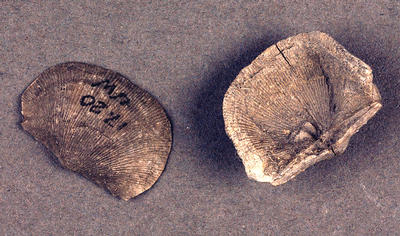
Fossil brachiopods (Chonetes) from Robroyston.
Brachiopods have existed for almost 600 million years (since the Cambrian Period), although they were more abundant and more species existed in the past than today. Although most creatures with two opposed hinged shells (such as cockles and mussels) are known as bivalves, brachiopods are so different internally that they belong to a separate phylum (a grouping of species). These two Chonetes specimens date from the Carboniferous Period (360-290 million years ago).
Chonetes lived on the sea-bed. They were spiny with concavo-convex shells, and it has been suggested that they escaped predators by quickly snapping their shells shut to produce a jet of water which pushed them to safety. Their fossils are often found crowded together in "nests" or beds.
Reference: 1917.20.uw
Reproduced with the permission of Glasgow City Council, Glasgow Museums
Keywords:
brachiopods, Cambrian period, Carboniferous Period, Chonetes, fossils, geology
You have 0 images in your photo album.